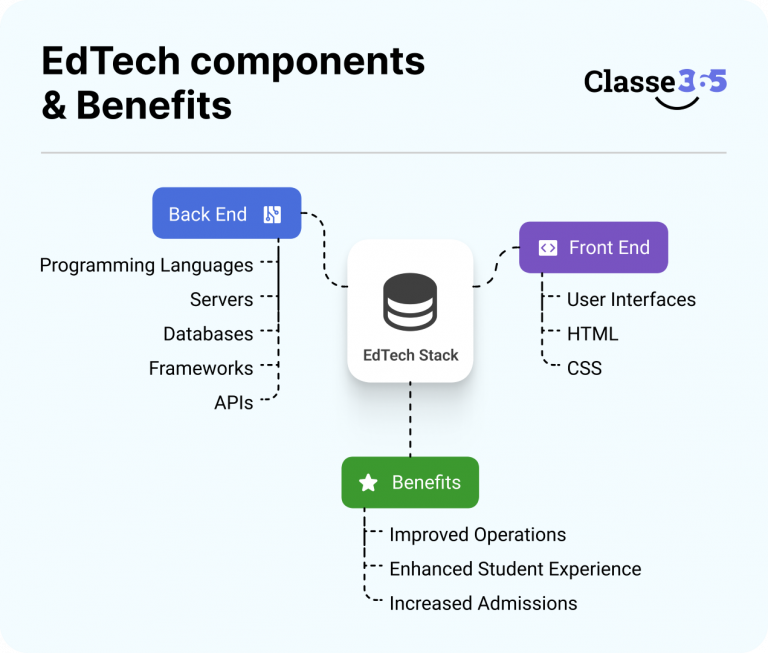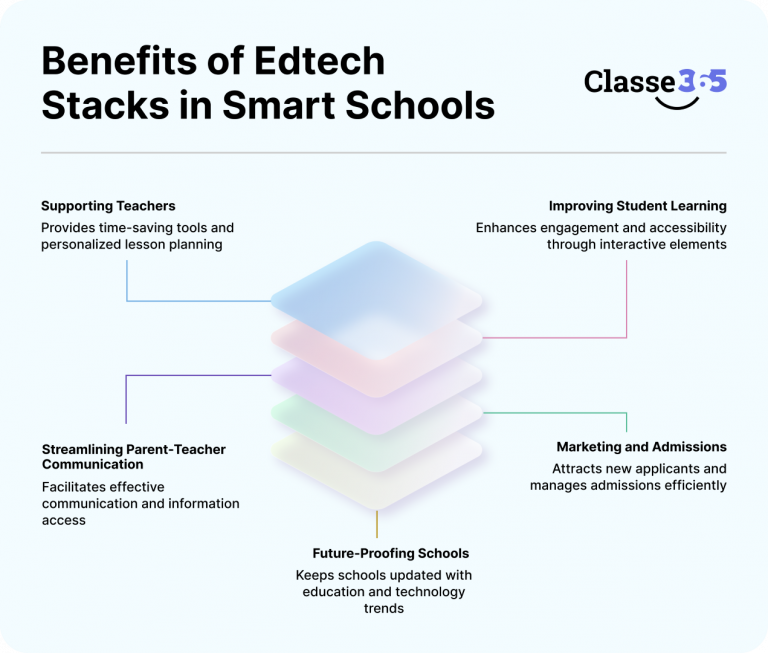With 64% of UK schools using technology in everyday teaching and learning practices, it’s important that smart schools utilise and layer the best apps and platforms to help them harness the power of Edtech to strive towards educational excellence.
Building the perfect edtech stack can help education institutes achieve administrative efficiency, optimal learning conditions for their students, and reduce additional stress on their teaching staff.
From hardware to software, this article will share how to build a strategic edtech stack and the benefits of adopting a tech-driven approach in schools, to attract, retain, and nurture students and teachers.
What is EdTech?
Education technology, or Edtech, means the use of technology in schools or other educational institutions.
Often, edtech is used to facilitate online learning, both in the classroom itself and remotely, allowing students and teachers to access e-learning resources from home.
Edtech is used to improve efficiency and the education experience of teachers, leading to more effective communication and more secure student data management. It can also lead to more accessible education and individual learning pathways.

What is an Edtech stack?
An EdTech stack consists of a collection of tools and technologies that, when used together, support the digital running of an education establishment.
A tech stack consists of various types of technologies that manage the front end (the side that users see) and the backend (the behind the scenes parts that make everything work smoothly). These components include:
- User interfaces – often made using HTML and CSS
- Programming languages, like Python or Java
- Servers
- Databases
- Frameworks
- APIs (application programming interfaces)
All of these will be made, managed and maintained by a skilled team of programmers and are designed to communicate with each other easily.
By embracing Edtech solutions, smart schools can invest in online tools, apps, software and hardware that improve operations, enhance the student experience and provide opportunities to expand awareness and drive more admissions.
How to build an edtech stack from scratch
When building an edtech stack, planning is important. Before diving into impulsive investing, taking time to evaluate existing practices and plan based on objectives, users’ needs and budget available can help you to strategically select the tools and technology that will make the biggest impact.
Audit your existing technology
A good place to start your edtech stack planning is by conducting a thorough audit of all the existing technology and tools that your school currently has. This can include anything from cloud computing and learning management systems to in-classroom interactive whiteboards and game-based learning platforms.
Consider how often it is used, and by who, as well as any ongoing associated costs, like subscriptions or maintenance. Think about the age of current technology and the expected life cycle.
Auditing your technology situation can help you identify any gaps in your edtech stack or existing tools that are being underutilised.
Define your goals
Building an effective edtech can play a pivotal role in your overall goals and objectives. By defining your goals, you can then look at how edtech can support your progress and help to achieve these objectives.
Do you want to focus on student experience or operational efficiency? Are you looking to increase applications or admissions, or improve communications?
Once you’ve figured out your priority areas, you can look for tech solutions that help you work towards improvement.
Evaluate your target users
Now you’ve defined your goals, you’ll likely have a clear idea of who your target users will be. Whether it’s students, teachers or parents, it’s important to understand your users’ needs and how the technology will enhance their experience.
Teachers may want time-saving features, while parents might look for simplicity, whereas students respond well to interactive elements. Understanding the user and their digital literacy, as well as their technological habits, can help you to tailor your edtech stack to be best received by their intended user.
Prioritise accessibility and usability
Auditing existing technology isn’t just focusing on whether the tool ‘does its job’. It’s also important to consider how easy it is for the user and how the user feels when using it.
Increasingly, accessibility and user experience are becoming central to the adoption of new and emerging technologies.
Evaluating how your current technology is performing from an accessibility and usability perspective can help you find alternative solutions that are more suitable and safe.
Understand what budget is available for edtech
With education budgets often lean, understanding what funds are available for technology can help you to plan for the best edtech stack within this budget. This can help you to really focus on edtech that will make the most impact, without wasting money and adding too much to your stack all at once.
Look into what grants may be available to support technology investment in schools or if there are any partnership opportunities with tech start-ups looking for case studies or to trial emerging education innovations.
Start simple
While it can be tempting to invest in multiple tools or technologies, if the budget is available, it’s often more effective and efficient to start with a simple stack. This will help you to avoid overinvesting in platforms or programmes that aren’t suitable for your needs or requirements.

How can edtech stacks benefit smart schools?
There are many benefits to investing in an edtech stack for smart schools, for students, parents and teachers, as well as prospective students and the future of the school.
Supporting teachers with time-saving tools
From lesson planning tools to performance analytics, edtech can present time-saving opportunities for teachers that help them to focus on teaching and their students instead of labour intensive admin.
Some edtech tools can help teachers to plan lessons based on analysing the whole class’s abilities and understanding of a topic, and create personalised lesson plans. This approach can help each student to maximise their potential and enhance their learning experience.
Similarly, Edtech can help teachers to monitor progression, with automatic grading and analysis of test scores. This can help alert teachers to sudden dips in performance or causes for concern, allowing teachers to identify areas of improvement.
Improving the learning experience for students
Adopting technology in the classroom can help to enhance the learning experience for students, by incorporating interactive elements and collaborative learning.
Utilising edtech can add variety to the classroom, allowing for different teaching styles, lesson delivery and types of tests. This can help adapt topics to all different learning styles, as well as help capture and keep students’ attention during lessons.
Edtech is a great way to get students more engaged with and excited by education, as well as increase accessibility through individual learning plans with minimal disruption to the student, their peers or teachers.
Edtech stacks that are accessible remotely can increase the chances of collaboration outside of the classroom by providing channels of communication between fellow students or students and teachers.
This can help students develop key skills like relationship building through community and connection, alongside their educational development.
Streamlining parent-teacher communications
Another area that can be greatly improved by adopting an edtech stack is how teachers and parents or guardians communicate about school related matters.
While emails have replaced paper letters sent home, and often lost by students, edtech can help create more effective communication for parents and teachers.
Edtech can provide a central location that digitally stores all important information for parents to access whenever they need to, as well as have oversight on workload, homework or their child’s schedule. Having more insight can help parents better support their child’s academic success.
Marketing for schools and managing admissions.
Edtech isn’t only useful for existing students, it can also be used to help to attract new applicants and increase admissions. Education marketing is increasingly important to maintain a sustained stream of admissions.
When it comes to marketing for schools, many smart schools are turning to targeted paid media campaigns in the local area to help drive awareness of their school, highlighting upcoming open days and showcasing stellar results.
Coupled with AI powered admissions tools, a targeted paid media campaign can help boost your applicants and manage the administration of admissions more easily.
Future-proofing your school with a smart edtech stack investing
With edtech evolving, it’s a smart move for schools to keep up with both education and technology trends in order to future-proof their operations, optimise their often limited budgets and maintain high-standards for students, teachers and staff.
Adopting a tech-forward approach can also help prepare pupils for the tech-driven world, getting them used to the platforms and programmes they will be using in a working environment of the future.
Final thoughts
As new technologies emerge, it can be hard to select the right stack to suit your budget and goals as an educational institute. But, with proper planning, schools can ensure they are curating a robust edtech stack that is targeted, rather than reactive, and that will stand the test of time with a future-proof strategy.
